How are top meat cuts used by all chefs useful to know
Some people are vegetarians and some are non vegetarians. In this food blog you will explore different types of meat. It is of great information for people who travel to different countries.
Firstly let us look at different types of meat available:-
- Red Meat – Beef, Goat, Lamb
- Poultry – Chicken and Turkey
- Pork – Pig’s meat
- Seafood –Fish, Crab, Lobster
The different food items that are made from various types of meat are as follows:
Bacon – Meat from the pig that is treated with smoke or salt and made into thin pieces
Sausage – Food usually made from ground meat with a skin around it and is cylindrical in shape.
Ham – Ham is pork that has been preserved through salting and smoking.
Pepperoni – Salami usually made from cured pork and beef mashed together. It is soft, slightly smoky and bright red in colour.
Salami – Salami is flattened sausage made of fermented and air dried meat from one of several animals typically beef or pork.
Steak – A steak is a cut of meat sliced perpendicular
Ribs – Ribs of pork, beef, lamb, and venison are a cut of meat. The term ribs usually refers to the less meaty part of the chops, often cooked as a slab.
Meat ranks among one of the most significant, nutritious and favored food item available to masses, which aids in fulfilling most of their body requirements.
It has played a vital role in human evolution and is an imperative constituent of a well-balanced diet. It is a good source of proteins, zinc, iron, selenium, and phosphorus followed by vitamin A and B-complex vitamins.
Average value of meat protein is about 23% that varies from higher to lower value according to the type of meat source.
Meat fat and its fatty acid profile is point to worry, with respect to its consumption, but its moderate usage is always advised by doctors and nutritionists, in order to lead a healthy life.
Fat content of animal carcasses ranges between 8 and 20%. Quality traits of meat along with its nutritional composition become dependent upon animal breed type, feeding source (grains, pasture and grass), genetics of animal and post mortem techniques.
What Is Chicken?
What Is the Correct Internal Temperature for Cooked Chicken?
Chicken is done cooking when its internal temperature reaches 165ºF (75ºC), regardless of cooking method, cooking temperature, and cut of meat—including white meat like chicken breasts and wings, and dark meat like drumsticks and thighs.

The 6 Edible Parts of a Chicken
Done right, no matter the cut, chicken is tender, juicy, and has the crispiest skin around. Remember: when butchering, kitchen shears are your friend.
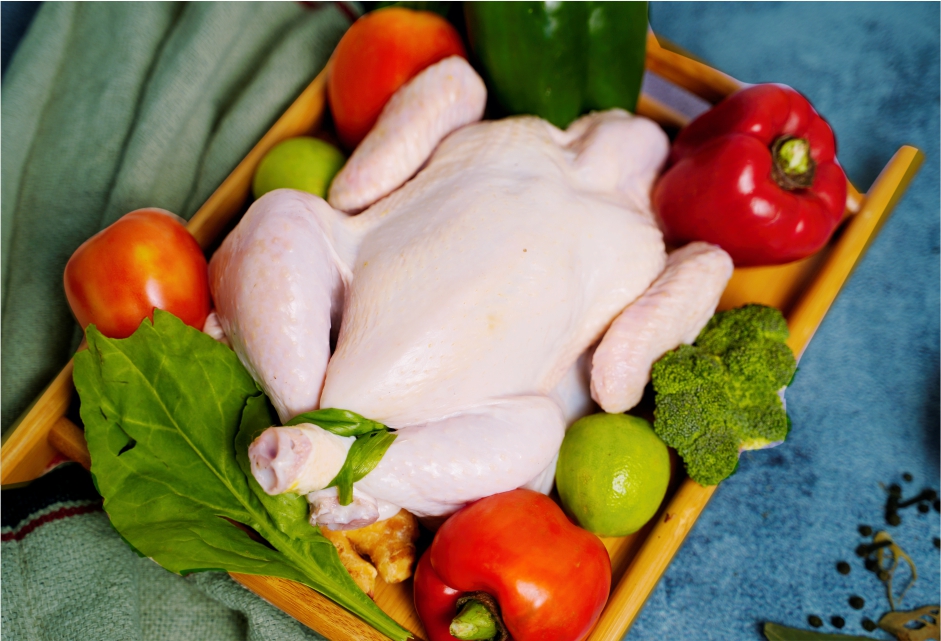
1. The Whole Bird: Sometimes, the best cut is all of them. A roasted chicken is one of life’s simplest pleasures. Brush the chicken with clarified butter and season all sides with salt, then roast in a 475°F oven for 20–25 minutes. Reduce heat to 400°F and continue to roast another 30-45 minutes, until thighs and center of breast registers 160°F and the juices run clear. Let rest at least 20 minutes before carving.
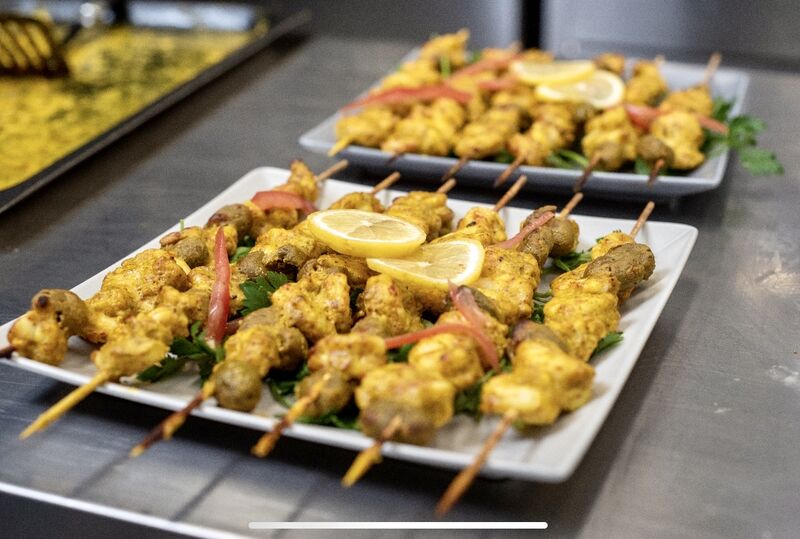
2. Chicken Breasts: The chicken breast is a lean cut of meat taken from the pectoral muscle on the underside of the chicken. Each whole chicken contains one chicken breast with two halves, which are typically separated during the butchering process and sold as individual breasts. Given its desirable white meat and health benefits, boneless, skinless chicken breast meat is the most expensive cut of chicken in comparison to chicken thighs, wings, and drumsticks, and can be grilled, baked, roasted, fried, barbecued, and boiled in countless ways.

3. Chicken Legs (aka Leg Quarters): The chicken thigh is a cut of poultry taken from the top portion of the leg, above the knee joint that separates the thigh from the chicken drumstick. This is an entirely dark-meat portion of the chicken, and is one of the most affordable cuts of the bird in comparison to more costly white-meat pieces like chicken breasts. Cooking times and results can also differ depending on whether a chicken thigh still has its skin on and bones intact. Boneless chicken thighs require less cooking time, making them a faster option for weeknight dinner recipes. Bone-in chicken thighs will retain moisture and flavor better, making for a generally more flavorful and succulent final product, but they will require extra cooking time. Soak in buttermilk, dredge in seasoned flour and fry for crispy Southern fried chicken, or marinate with ginger, garlic, and lemon juice before you pan-sear.
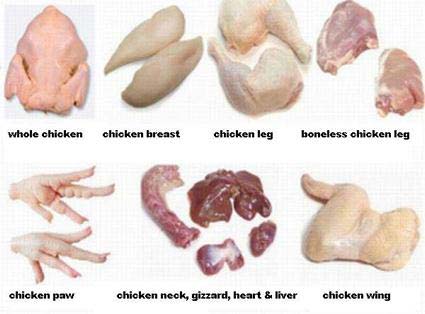
4. Chicken Wings: The chicken wing features two edible parts: the drumette, which resembles a smaller drumstick with white meat, and the flat, which contains tender white meat between two bones. Commonly known as bar food, chicken wings are also delicious when coated with a mixture of your favorite jam, balsamic vinegar, ground ginger and ground garlic and baked at 385°F, turning until skin is crisp and caramelized.
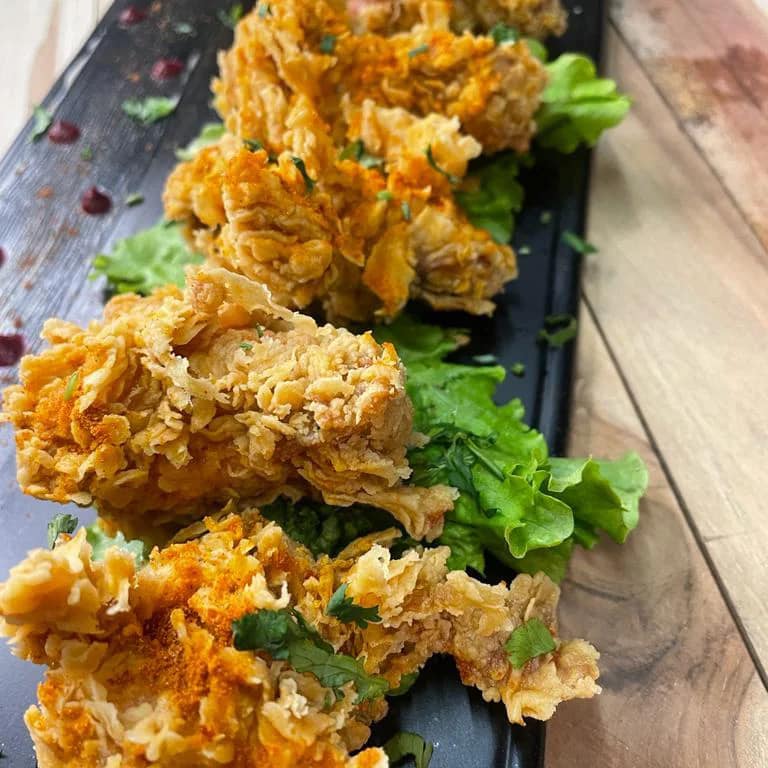
5. The Bones: Put all your leftover chicken bones to work and make a versatile chicken stock or chicken broth. Light, golden chicken stock is the workhorse of restaurant kitchens. It’s used for cooking pasta and as a building block for sauces. Reduced and fortified, it can be turned into a delicious soup. “Light” describes its color, but it also means that it cooks for a relatively short time, around 45 minutes at a simmer. Start by cleaning your chicken parts thoroughly—necks, backs, legs and all—removing any blood bits, liver, heart, or other impurities. The cleaner your chicken, the brighter the flavors of your stock will be.

6. The Fat: You can use the fat that accumulates on top of the stock in a variety of ways. Heating it over low heat to evaporate off all the water and straining it to remove impurities. You can roast potatoes or root vegetables with it, or make latkes with it. Store in an airtight container in the fridge for 2 weeks and freeze after that.

Poultry Cuts
Refers to the edible flesh, with adhering bones, of any bird that is commonly used as food. Types of poultry include chickens, ducks, geese, turkey, quail, pheasant. All poultry is processed in a similar manner. It is either cooked whole or segmented in a number of ways depending on how it is to be used.
All segments of small, young poultry can be prepared using dry heat cooking methods. Older birds, once they stop laying eggs, are butchered and marketed as stewing hens or boiling fowl. These birds need moist heat preparation and are ideal for pot pies, stews, and soups. All poultry should be fully cooked to at least 74°C (165°F) to eliminate the presence of salmonella.

A bird can be split in half lengthwise through the backbones and keel bone, or it can be split into a front quarter and a hind quarter. The front quarter of the bird contains the breast and wing meats, while the hindquarter contains the legs. It is common to further break the poultry into segments.
For maximum yield and precise processing, poultry can be segmented by cutting through the soft natural joints of the bird. The term 8-cut chicken is used to describe a chicken segmented into two drumsticks, two thighs, and both breasts split in half across the rib bone (one half may contain the wing). This procedure is always done with the bone in. These segments can be processed further to boneless skinless cuts if desired.
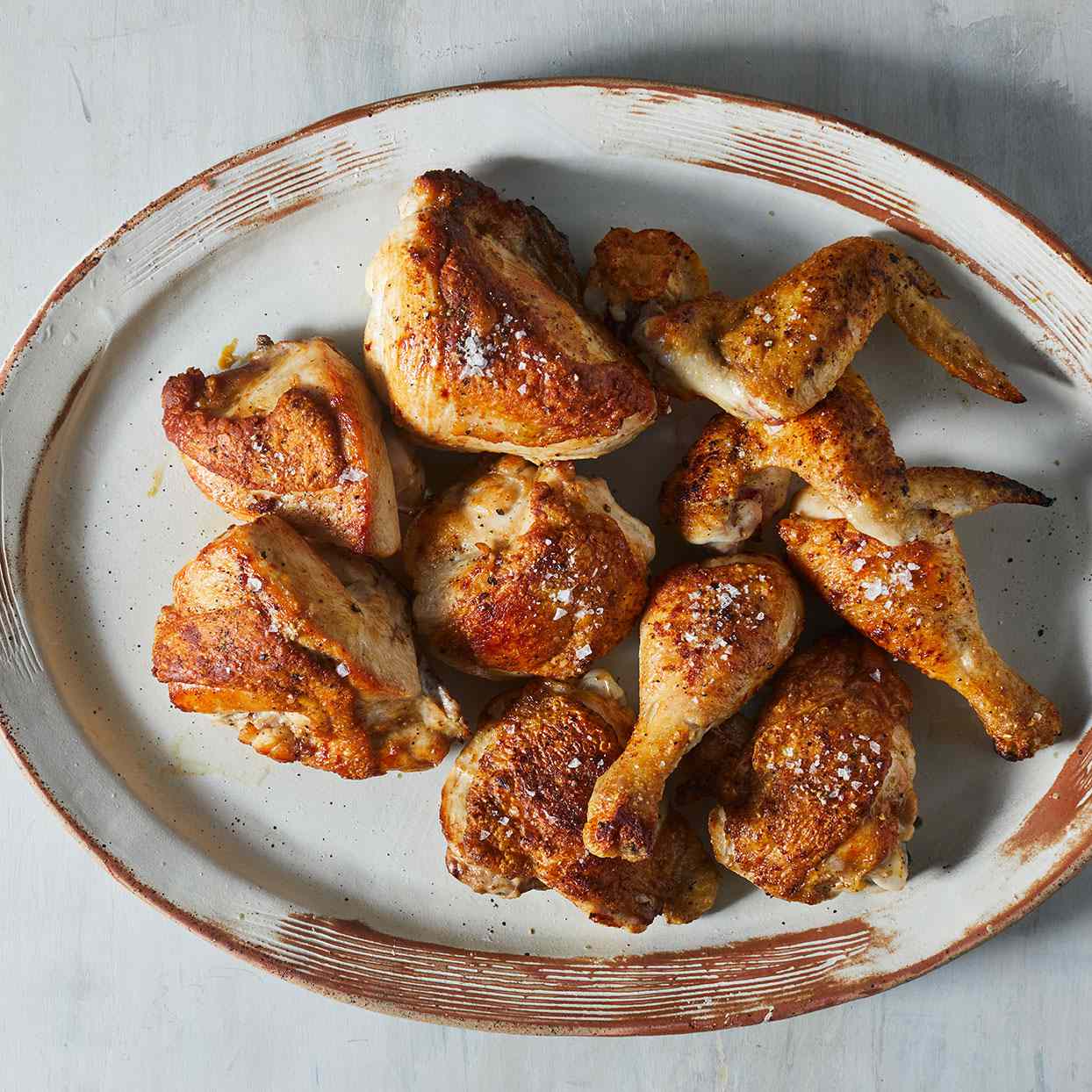
| Cut | Retail Cuts | Restaurant Cuts |
| Chicken breast | Chicken breastbone in | Suprême (chicken breast with wing drumette attached) |
| Chicken breast boneless/skinless | ||
| Chicken breast fillets (or tenders) | ||
| Chicken leg | Chicken leg (back attached) | Chicken Ballotine (boneless leg) |
| Chicken drumstick | ||
| Chicken thigh (bone in) | ||
| Chicken thigh (boneless skinless) | ||
| Chicken wing | Chicken wing (whole) | Chicken wings split, tips removed |
| Chicken winglette (or wingette) | ||
| Chicken wing drumette | ||
| Chicken wing tip | ||
| Backs and Necks | Chicken backs and necks | Chicken ribs, backs and necks are used for stock |
White Meat Cuts
White or light meat comes from the breast and wings. The breast and wings are generally separated, but a chicken breast with the drumette portion of the wing still attached is called a . Wings can be broken down into three parts: wing tip, winglette, and wing drumette.
The breast can also be broken down further and the tenderloins () removed. The portion without the tenderloin can be split and pounded into a thin cutlet known as a . Figure shows the chicken breast whole and with the fillets removed from the bottom portion.
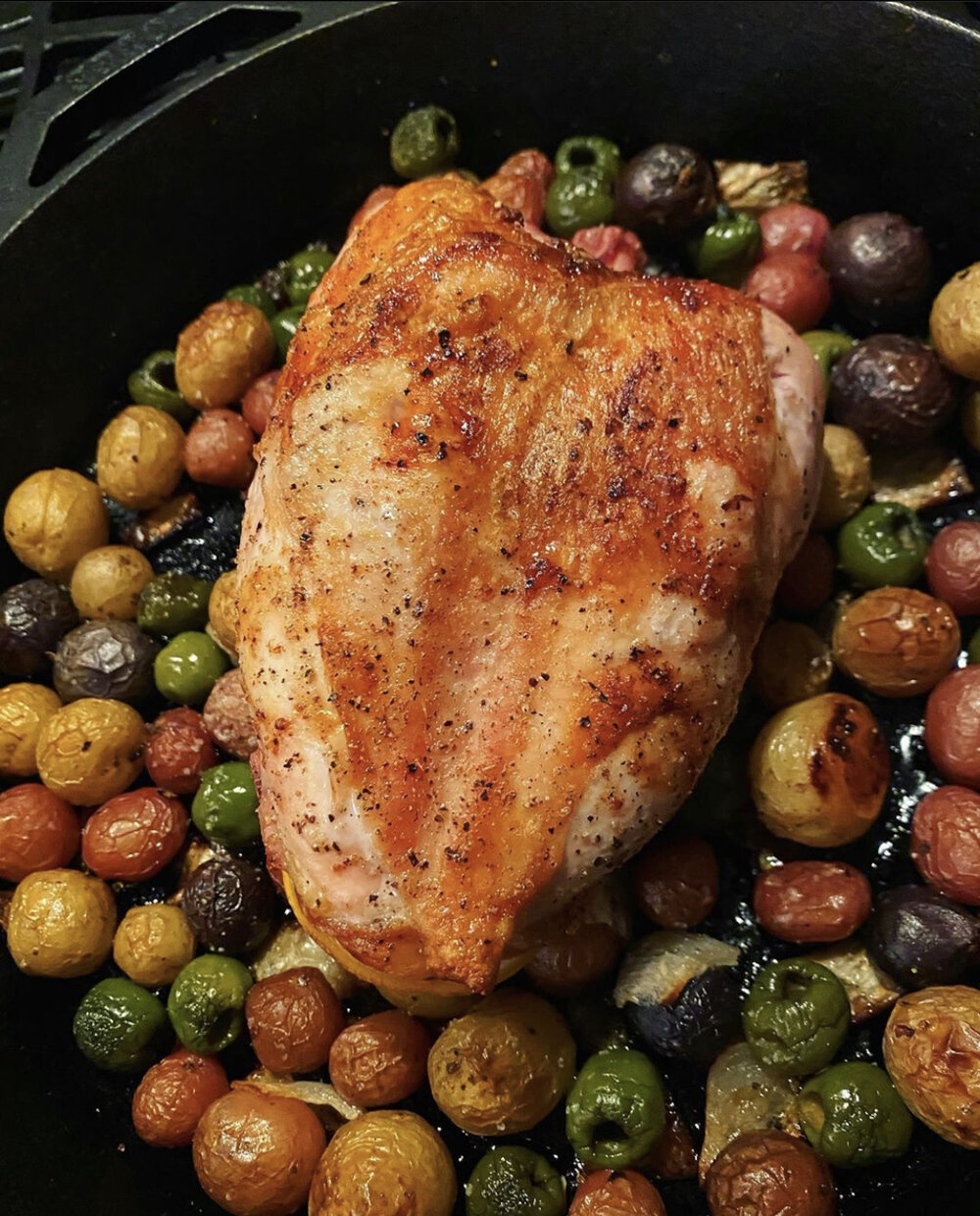
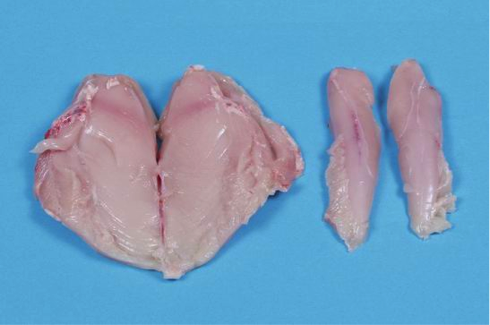
Dark Meat Cuts
The dark meat of poultry comes from the legs, which can be broken down into two parts: the thigh and the drumstick. In restaurants, you may occasionally find a boneless leg that has been stuffed, which is called a .
Chicken legs are split at the knee joint to separate the thigh from the drumstick. Drumsticks are usually cooked bone in, while thighs can be deboned and skinned to use in a variety of dishes, including slicing or dicing for stir-frys and similar dishes.
Figure shows a whole chicken leg broken down into a drumstick and boneless thigh.

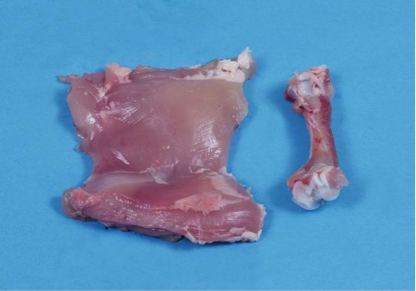

Chicken can be prepared in a vast range of ways, including baking, grilling, barbecuing, frying, and boiling. Since the latter half of the 20th century, prepared chicken has become a staple of fast food. Chicken is sometimes cited as being more healthful than red meat, with lower concentrations of cholesterol and saturated fat.
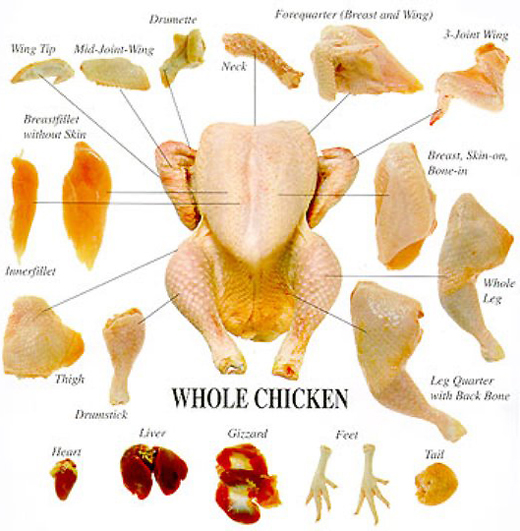
The poultry farming industry that accounts for chicken production takes on a range of forms across different parts of the world. In developed countries, chickens are typically subject to intensive farming methods while less-developed areas raise chickens using more traditional farming techniques.
Lamb vs. Mutton: What’s the Difference?
Lamb and mutton are two types of meat with different uses in the culinary world. Learn about the differences between the two types of red meat.

What Is Lamb?
Lamb is the meat of a young domestic sheep, typically around a year old. Since the animal is young, there is little fat or dense muscle, resulting in mild, moist, and tender meat. Lamb is popular premium meat in the US, Europe, and the Middle East, where chefs prepare it in various ways, including braising, grilling, and roasting. Common cuts of lamb include lamb chops, lamb shoulder, lamb loin, lamb shank, leg of lamb, rack of lamb, and ground lamb.
Some butchers also distinguish lamb from spring lamb: While lamb is meat from an older lamb (around one year), spring lamb is under three months.
What Is Mutton?
Mutton is the meat of a mature adult sheep, typically between two and three years old. Producers can harvest mutton from a ewe (female) or wether (castrated male). Since the animal is older, it contains more fat and muscle, resulting in a stronger flavor and denser, tougher texture. While mutton isn’t popular in the United States, it is a ubiquitous protein in Middle Eastern and Indian cuisine, especially in mutton curries, biryanis, stews, kebabs, and slow-cooking and slow-roasting recipes.
In certain parts of the world, mutton has different meanings and names. For example, chefs in New Zealand and Australia use the term “sheep meat” to describe mutton and “hogget” or “yearling” to describe the meat of a young sheep between one and two years of age. In South Asia and the Caribbean, chefs may use “mutton” to refer to goat meat.
Mutton vs. Lamb: 4 Differences Between the Meats
Mutton and lamb are two types of meat from sheep at different life cycle stages. Here are the main differences between the two types of red meat:
Age: The key difference between mutton and lamb meats is the animal’s age. While mutton refers to the meat of an older animal (typically around three years old), lamb is the meat of a young animal (often around a year old).
Flavor: Lamb is a younger animal, so the meat hasn’t had time to develop as much flavor—thus, it is milder with a faint, grassy flavor. Alternatively, mutton comes from an older sheep with more fat and muscles, giving it a strong, gamey flavor similar to goat, venison, or wild boar.
Preparation: Due to its toughness, mutton tastes best when cooked slowly, which you can do using a slow cooker, slow-roaster, or meat smoker. In Kentucky, chefs sometimes use the mutton of older sheep for barbecuing. Lamb, however, is a tender cut of meat that benefits from a range of cooking methods, including roasting, grilling, and braising.
Texture: Mutton comes from older sheep that have had more time to develop dense muscles and fat content, resulting in tough meat that can be dry or chewy. Conversely, lamb hasn’t had the time to develop much connective tissue, so the meat is often more tender and moist.
WHAT’S THE DIFFERENCE BETWEEN LAMB, MUTTON, AND GOAT MEAT
Have you ever wondered ‘What’s The Difference Between Lamb, Mutton, and Goat Meat‘?

Let’s start with the basic differences between the three before getting into finer detail. Lamb and mutton meats are from sheep, and goat meat is from goats. This is true for most countries unless you’re in South Asia ( India ), Australia, or Jamaica.
In India, the meat from a goat can also be referred to as mutton or sheep interchangeably. However, this is not the case in the United States and Europe.
I’ll get more specific now. In this article, I refer primarily to terminology in the US and Europe.

DIFFERENCE BETWEEN SHEEP AND GOATS
Sheep are a different species than goats. Sheep (Ovine species) can have wool or hair, so that is not how to differentiate the two species.
The best way to tell, if you were looking out into a field of grazing animals, is that sheep have tails that hang down. Goats (Caprine species) have tails that point upward.
SHEEP TERMINOLOGY BY AGE AND GENDER
Lamb (in general) – is a sheep under one year of age. The meat is very tender and has less fat than older sheep.
American lamb is typically fed milk and grain, which yields a milder flavor still. Imported meat from Australia or New Zealand has been grass-fed and will have a slightly stronger flavor than domestic lamb meat.
Milk Lamb – a very young lamb, between 4 – 6 weeks of age. Milk-fed only and has superbly tender meat with a mild flavor.
Spring Lamb – a baby lamb, under 3 – 5 months of age. These lambs are primarily milk and grain-fed and typically sold around Easter or before June 1st. The meat is lighter in color, a pale pink. It is more tender than older lamb meat and has a more mild flavor due to the lower fat content.
Ram Lamb – a male lamb, under one year of age.
Ewe Lamb – a female lamb, under one year of age.
Hogget – a male or female sheep between 1 – 2 years of age, sometimes called ‘yearling mutton’. The meat from a hogget sheep is a combination of the tenderness expected of a young lamb and the gamey flavor of older sheep or mutton meat.
Mutton – sheep meat from a male (typically a castrated male) or female sheep over 2 years of age. The flavor of mutton is very strongly gamey to most Americans, which is why it is not commonly sold outside of specialty butcher shops or sheep farms.
The strong flavor is due to the higher fat content in adult sheep. To reduce the gamey flavor, you should trim off any excess fat.
Mutton meat is best eaten when around 4 years of age. The meat should be a deep red in color, as the meat from older animals is darker than lamb meat.
Ram (sometimes called a ‘tup’ – a mature male sheep capable of reproducing.
Ewe – a mature female sheep.
Wether – a castrated male sheep.
*Now, to add some confusion, I’ve sometimes heard any castrated male sheep (a wether) referred to as mutton. This is most likely because that male would be intended to be used for meat.
Sheep are raised for their wool, meat, hides, and only occasionally for milk. There are a few specialty kinds of cheese produced from sheep’s milk.
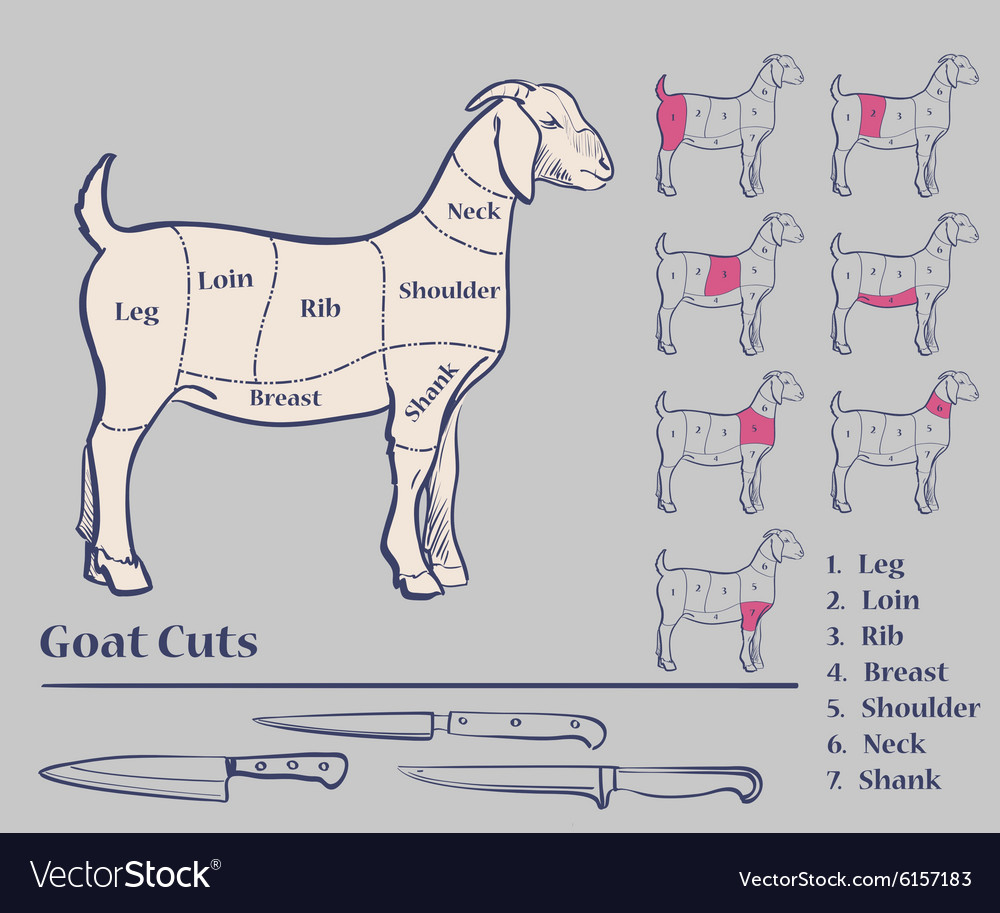
GOAT TERMINOLOGY BY AGE AND GENDER
Kid – a young goat under one year of age of either sex, male or female.
Buckling – a young male under one year of age is sometimes called a buckling.
Buck or Billy – a mature male goat capable of reproducing.
Wether – a castrated mature male goat, wethers intended for meat are castrated between 6 – 9 months of age and processed for meat typically before one year of age.
Doe or Nanny – a mature female goat.
Goat Meat, Goat’s Meat, or Chevron – goat or goat’s meat from adult goats. The lean goat meat has a stronger game flavor as the animals mature.
Kid, Capretto, Cabrito, or Natalie – cabrito is goat meat from a grass-fed young goat. Kid, capretto, or natalie is young goat meat under one year of age. Like lamb vs mutton, the gamey flavor of goat meat is milder in the meat from kid goats.
Goats are raised for their meat, milk, fibre ( hair ), and hides. Locally ( here where I live in Minnesota ), goats can also be rented to clear areas of heavy underbrush and weeds.
Both the meat from sheep ( lamb and mutton ) and goat’s meat ( kid and chevron ) are red meats like beef. Both sheep ( lamb and mutton ) and goat’s meat ( kid and chevron ) are inspected by the USDA at approved facilities.
LAMB VS GOAT – THE DIFFERENCE BETWEEN LAMB MEAT & GOAT MEAT
- When considering overall nutrition, goat meat is generally considered to be healthier meat than lamb or mutton meat.
- Goat meat is slightly sweeter and milder than lamb meat.
- Goat meat has more protein per ounce of meat than lamb or mutton meat.
- Lamb meat has a higher fat content than goat meat ( the fat is where the gamey flavor is most noticeable ).
- The distinctive odor of lamb meat is due to caprylic acid stored in the fatty portions of lamb cuts.
- Since goat meat has less fat and marbling than lamb it is generally a tougher cut of red meat than lamb.
When purchasing lamb meat, you should look at the texture of the meat. It should be fine-grained and vary in shades of light pink to red ( depending on age, the older the animal, the deeper the color of red in the meat ).
Fine white marbling should be present in the meat muscle, and the white fat should be firm but not too thick in any area of the meat portion.
Mutton meat will have a larger, more open, grain texture. The marbling should still be fine, and the fat should be obviously white, not off-color.
Pork Cuts

There are 7 primal cuts on pigs. These are the big butcher’s cuts that you see if you’ve ever had the chance to watch your local butcher break down a pig. Each of the primal cuts are broken down into smaller pieces and that’s where we get cuts like pork loin, pork chops, and bacon.
Here’s a brief guide to the primal cuts of pig.
Pork Butt (or Boston Butt)
Its name is deceiving. The Pork Butt actually comes from the shoulder of the pig. It includes the neck, shoulder blade, and upper arm of the pig. As you might know, the Pork Butt is a moderately tough cut of meat that is ideal for slow roasting, braising or smoking. Pulled pork anyone? It’s also great for making pork sausages or ground pork.
Picnic Shoulder
Also known as the pork shoulder, the Picnic Shoulder comes from right below the Pork Butt. It is usually smoked or cured and is great for ground pork and sausages. You can roast it, but that’s not the best use for the Picnic Shoulder.
Pork Loin
One of our personal favorite primal cuts, the Pork Loin is where we get the tenderloin, fatback, and baby back ribs. You can choose to roast the entire loin or you can cut it into pork chops or cutlets. The upper ribcage area gives us the baby back ribs that we all know and love. A lesser known cut to come out of the Pork Loin is the fatback which can be added to ground pork or sausages or used to make lard or salt pork.
Ham
The back leg of the pig is where we get ham. When it is smoked and cured, this is where you get serrano ham and prosciutto. The entire fresh ham is typically roasted, but can be cut into ham steaks as well.
The Ham is also where the ham hock, a quintessential part of Southern cuisine, comes from. Found at the joint between the shank and the end of the ham, the ham hock is what is usually braised with collards or other dense greens.
Pork Side
Moving to the bottom of the pig, you get the Pork Side. This is where you get pork belly, bacon, and pancetta. These cuts are prepared a variety of different ways from slow roasting to frying.
Spare Rib
The Spare Rib is located between the Loin and the Pork Side. The Spare Ribs are usually grilled low and slow to ensure they are moist and tender. They can also be braised or cooked in a slow cooker.
Pork Jowl
A lesser known cut to the United States, the Pork Jowl is usually used for making sausages. Some restaurants have started to serve pork collar and pork cheeks which both come from the Pork Jowl.
Pork Foot
Typically reserved for adding to stocks, soups, and stews, the Pork Foot contains a lot of collagen and is a good source of gelatin. Slow stewing or simmering breaks down the connective tissue and makes the meat tender. Pork Foot can also be slow smoked, cured or pickled.
Let us know your favorite cut of pork in the comments!

Nutritional composition of meat
Meat ranks among one of the most significant, nutritious and energy-rich natural food product, utilized by the humans to fulfill their regular body requirements. It is considered quite important in maintaining a healthy and balanced diet, which is essential in accomplishing optimum human growth and development.
Although, few epidemiological studies have also pointed a possible relationship between its consumption and the elevated risks of having cardiovascular diseases, various forms of cancers and metabolic disorders but still its role in the human species evolution, specifically in its brain and intellectual development cannot be ignored .
From the nutritional point of view, meat is considered as a rich essential amino acids source whereas, mineral contents to a lesser extent. Apart from it, essential fatty acids and vitamins also make a part of it. Organ meat like liver is quite an enriched source of Vitamin A, Vitamin B1 and nicotinic acid.
The research is still in progress for the better understanding of the probable differences among the nutritional value of different meat cuts, variant animal species and breeds. It is quite evident from the previous research that the meat having lesser connective tissues is likely to have low scores of digestion and absorption.
Water
Water is one of the important constituents of all food materials. In general, there are three types of food products depending upon their moisture contents, firstly perishable commodities (having more than 70% moisture content in them), non-perishable commodities (having around 50–60% moisture contents) and stable food materials (with less than 15% moisture). The more the water content of any food material the lesser are the chances of its longer shelf life as micro-organisms have greater chance to grow on them that in turn, limit their lives.
Meat ranks among the perishable food material, as it contain around more than 70% of moisture in it. Apart from reduction in shelf life, its presence imparts a strong impact on the color, texture and flavor of muscle tissues of meat.
Carbohydrates
The main source of the carbohydrate in the animal body is its liver, which contains about ½ of the total carbohydrates present in the body. They are stored in the form of “glycogen” mainly in the liver and muscles but also in glands and organs to lesser extent. Its substantial quantities
Proteins and its amino acids
Meat ranks among one of the protein-rich foods, providing high biological value to the masses. Proteins are naturally occurring complex nitrogenous compounds having very high molecular weight consisting of carbon, hydrogen, oxygen and most importantly nitrogen. Few of the proteins also have phosphorous and sulfur in their structures.
| Meat cut | Protein (g) | Sat. fat (g) | Fat (g) | Energy (kcal) | Vit. B12 (mcg) | Na (mg) | Zn (mg) | P (mg) | Fe (mg) |
|---|---|---|---|---|---|---|---|---|---|
| Chicken breast, raw | 24.2 | 0.2 | 8.5 | 178 | 0.39 | 71 | 0.9 | 199 | 1.2 |
| Beef, steak cuts, raw | 21 | 1.9 | 4.5 | 123 | 1.9 | 59 | 1.7 | 167 | 1.3 |
| Chicken, raw | 22.8 | 0.6 | 1.9 | 113 | 0.70 | 78 | 1.4 | 202 | 0.7 |
| Beef, calf, loin, raw | 20 | 3.4 | 7.3 | 146 | 1.1 | 22 | 3 | 193 | 0.10 |
| Beef, loin, raw | 20.9 | 1.5 | 3.2 | 115 | 2 | 59 | 3.7 | 142 | 1.6 |
| Pork, chop, raw | 18.1 | 10.8 | 31.7 | 353 | 1 | 60 | 1.8 | 190 | 1.4 |
| Pork, loin, raw | 21.9 | 1.7 | 4.9 | 134 | 1.1 | 55 | 1.9 | 220 | 0.7 |
| Pork, leg, raw | 20.8 | 2.8 | 7.8 | 155 | 1.2 | 84 | 2.6 | 164 | 0.8 |
| Turkey, skinless, raw | 19.9 | 1.8 | 7.1 | 136 | 1.9 | 42 | 1.5 | 209 | 2.1 |
| Duck meat, skinless, raw | 19.4 | 1.8 | 6.6 | 130 | 2.8 | 90 | 1.8 | 201 | 2.5 |
| Turkey, breast, skinless, raw | 23.6 | 0.5 | 1.6 | 106 | 1 | 62 | 0.5 | 208 | 0.6 |
| Chicken breast, skinless, raw | 23.8 | 0.4 | 1.28 | 109 | 0.40 | 59 | 0.7 | 218 | 0.4 |
| Mutton, chop or meat, raw | 20 | 2.4 | 4.8 | 122 | 2 | 63 | 3.6 | 221 | 1.9 |
Table 1.
Nutritional composition of meat
| Essential amino acids | ||||
|---|---|---|---|---|
| Amino acids | Category | Beef | Lamb | Pork |
| Lysine | Essential | 8.2 | 7.5 | 7.9 |
| Leucine | Essential | 8.5 | 7.2 | 7.6 |
| Isoleucine | Essential | 5.0 | 4.7 | 4.8 |
| Cystine | Essential | 1.5 | 1.5 | 1.2 |
| Threonine | Essential | 4.2 | 4.8 | 5.2 |
| Methionine | Essential | 2.2 | 2.4 | 2.6 |
| Tryptophan | Essential | 1.3 | 1.2 | 1.5 |
| Phenylalanine | Essential | 4.1 | 3.8 | 4.3 |
| Arginine | Essential | 6.4 | 6.8 | 6.6 |
| Histidine | Essential | 2.8 | 2.9 | 3.1 |
| Valine | Essential | 5.6 | 5.1 | 5.2 |
| Non-essential amino acids | ||||
| Amino acid | Category | Beef | Lamb | Pork |
| Proline | Non-essential | 5.2 | 4.7 | 4.4 |
| Glutamic acid | Non-essential | 14.3 | 14.5 | 14.6 |
| Aspartic acid | Non-essential | 8.9 | 8.6 | 8.8 |
| Glycine | Non-essential | 7.2 | 6.8 | 6.0 |
| Tyrosine | Non-essential | 3.3 | 3.3 | 3.1 |
| Serine | Non-essential | 3.9 | 3.8 | 4.1 |
| Alanine | Non-essential | 6.3 | 6.2 | 6.4 |
Table 2.
Amino acid composition in fresh meat
The beef meat appears to have higher contents of valine, lysine and leucine as compared to lamb and pork. Studies have revealed that main reason of the difference in essential amino acid proportion lies with the breed, animal age and muscle location.
Sometimes the interaction of the other constituents with the proteins has put an effect on the availability of essential amino acids. Smoking and salting of the meat has also played its role in this regard. Apart from the effect of the processing conditions, the storage has also imparted its effect on amino acids, in case of canned meat
Fat and fatty acids
Fats rank among one of the three major macro-nutrients, including carbohydrates and proteins. Fat contents are known as triglycerides that are esters of three fatty acid chains and the alcohol glycerol.
Meat contains fatty tissues (fat cells filled with lipids) that have varying amount of fat. In meat, fat content functions as energy deposits, protective padding in the skin and around organs especially heart and kidney as well as provides insulation against body temperature losses . Fat content in animal carcass varies from 8 to 20% (latter is only in pork). The fatty acid and fat composition of fatty tissue differs significantly in different locations among poultry and other meat products such as offal, sausages and ham etc.
| Meat source | Cholesterol (mg/100 g) | C-18:2 | C-18:3 | C-20:3 | C-20:4 | C-22:5 | C-22:6 |
|---|---|---|---|---|---|---|---|
| Mutton | 81 | 2.4 | 2.4 | Nil | Nil | Trace | Nil |
| Beef | 62 | 2.1 | 1.4 | Trace | 1.1 | Trace | Nil |
| Pork | 71 | 7.5 | 1.0 | Nil | Trace | Trace | 1.1 |
| Brain | 2200 | 0.5 | Nil | 1.6 | 4.1 | 3.5 | 0.4 |
| Pig’s Kidney | 415 | 11.6 | 0.4 | 0.5 | 6.72 | Trace | Nil |
| Sheep’s Kidney | 399 | 8.2 | 4.1 | 0.6 | 7.2 | Trace | Nil |
| Ox’s kidney | 401 | 4.9 | 0.6 | Trace | 2.7 | Nil | Nil |
| Sheep’s Liver | 429 | 5.1 | 3.9 | 0.7 | 5.2 | 3.1 | 2.3 |
| Pig’s Liver | 262 | 14.8 | 0.4 | 1.2 | 14.4 | 2.4 | 3.9 |
| Ox ’s Liver | 271 | 7.5 | 2.4 | 4.5 | 6.5 | 5.4 | 1.3 |
Table.
Polyunsaturated fatty acids and cholesterol in lean meat and offal (as % total fatty acids).
It is obvious that the linoleic acid concentration is more in lean meat of pig than in ox or sheep meat. These variations in concentration of fatty acids composition among different species are also revealed in kidney and liver fatty acid profile.
From the number of polyunsaturated fatty acids, omega 3 fatty acids justify their special attention as they play a protective role in general human health particularly cardiovascular diseases. Seafood is the main source of omega 3 fatty acids. Though, meat can contribute up to 20% of long chain omega 3 polyunsaturated fatty acids intake.
Organ meat as a mineral source
It is quite evident that the offal organs are quite rich in the mineral contents like iron, zinc, and copper as compared to the minerals that are present in muscular tissues. The children on the fully vegetarian diet could lead them to retarded cognitive activity owing to zinc deficiency, so the ingestion of meat stuff has been emphasized . Mineral contents of offal organs are depicted
| Meat source | K | Cu | Fe | P | Zn | Mg | Na | Ca |
|---|---|---|---|---|---|---|---|---|
| Chopped Mutton, (raw) | 244 | 0.15 | 0.99 | 174 | 4.2 | 18.8 | 74 | 12.5 |
| Chopped Mutton, (grilled) | 303 | 0.25 | 2.5 | 205 | 4.2 | 22.7 | 101 | 17.9 |
| Beef, Steak (raw) | 335 | 0.1 | 2.4 | 275 | 4.2 | 24.4 | 68 | 5.5 |
| Beef, Steak (grilled) | 369 | 0.22 | 3.8 | 302 | 5.8 | 25.1 | 66 | 901 |
| Bacon (raw) | 267 | 0.2 | 1.0 | 95 | 2.4 | 12.2 | 976 | 13.6 |
| Bacon, (fried) | 516 | 0.2 | 2.7 | 228 | 3.7 | 25.8 | 2792 | 11.6 |
| Pork (raw) | 399 | 0.1 | 1.5 | 224 | 2.5 | 26.2 | 44 | 4.2 |
| Chopped Pork, (grilled) | 259 | 0.1 | 2.5 | 179 | 3.6 | 14.8 | 60 | 8.2 |
The 8 Cuts of Beef
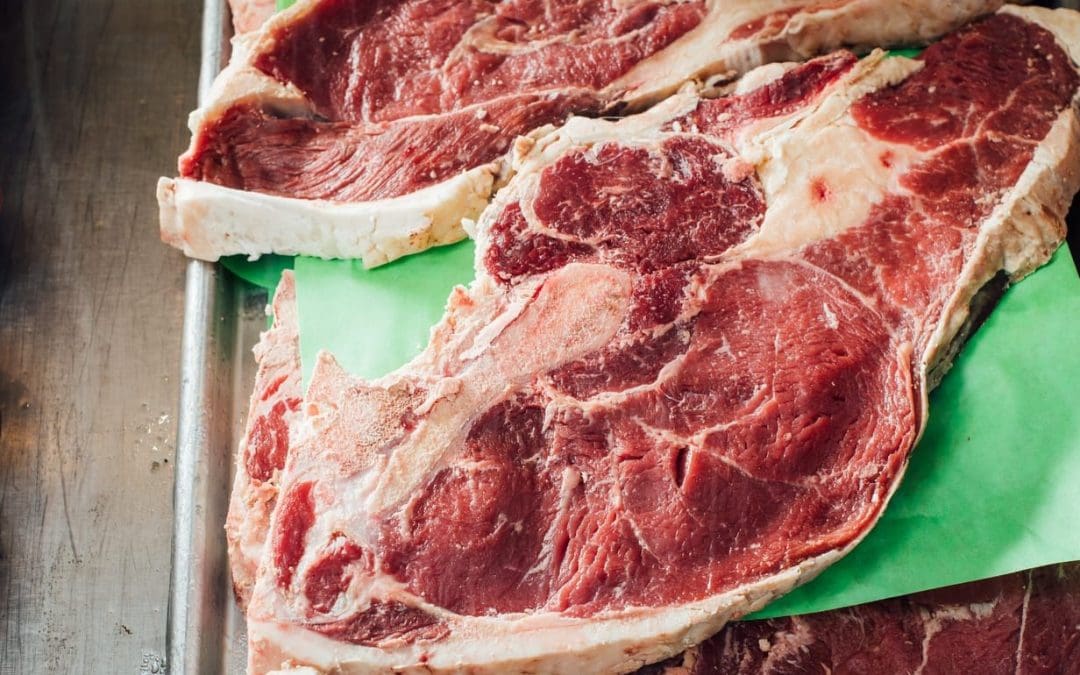
When buying, preparing and cooking meat, it can be easy to fall into the same old song and dance. While there’s nothing wrong with eating what’s familiar to you, knowing the different cuts of meat and what they’re best used for can help expand your cooking options while also help to avoid costly shopping mistakes (like using tough cuts for low and slow recipes).
With some stores carrying as many as 60 different types of beef products, it’s easy to understand why most people can’t make heads or tails of all the different cuts of beef. Additionally, while there are some federal USDA standards that dictate meat labeling, these standards generally only apply to larger cuts of meat that are not usually available for purchase from most grocery stores (and even some retail butchers).
But don’t worry – we’re experts at this stuff – and we’re here to help you understand the different cuts of beef and how best to prepare them!
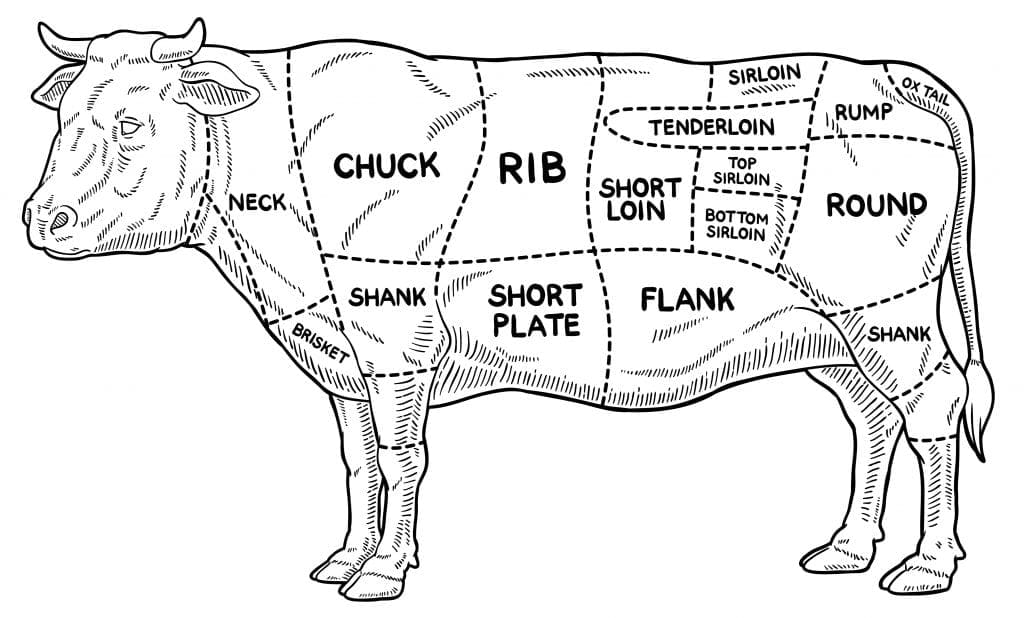
Cut To The Chase: Primal, Subprimal and Portion Cuts
To start, there are eight main cuts of beef known as the primal cuts, listed below:
- Chuck
- Rib
- Loin
- Round
- Flank
- Short Plate
- Brisket
- Shank
These large primal cuts are then divided into smaller subprimal cuts that are shipped by packers to local markets for final cutting and preparation. These final cuts are known as portion cuts, and are the cuts of meat that consumers will find in their local stores like steaks, ribs and roasts.
We’re going to cut through some of this beef-buying complexity by focusing on the eight main primal regions as well as their most common portion cuts. For most consumers, understanding these main cuts and what makes them distinctive is sufficient enough for informed beef buying.
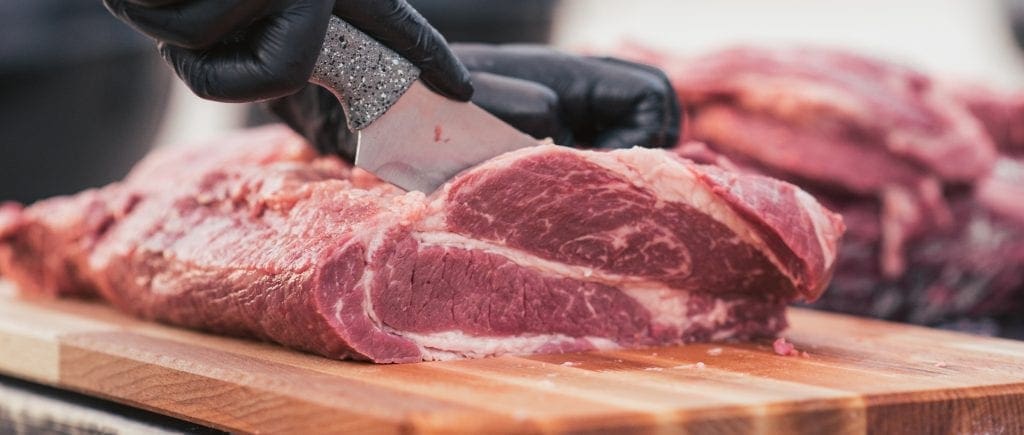
Uderstanding the Meat You Eat.
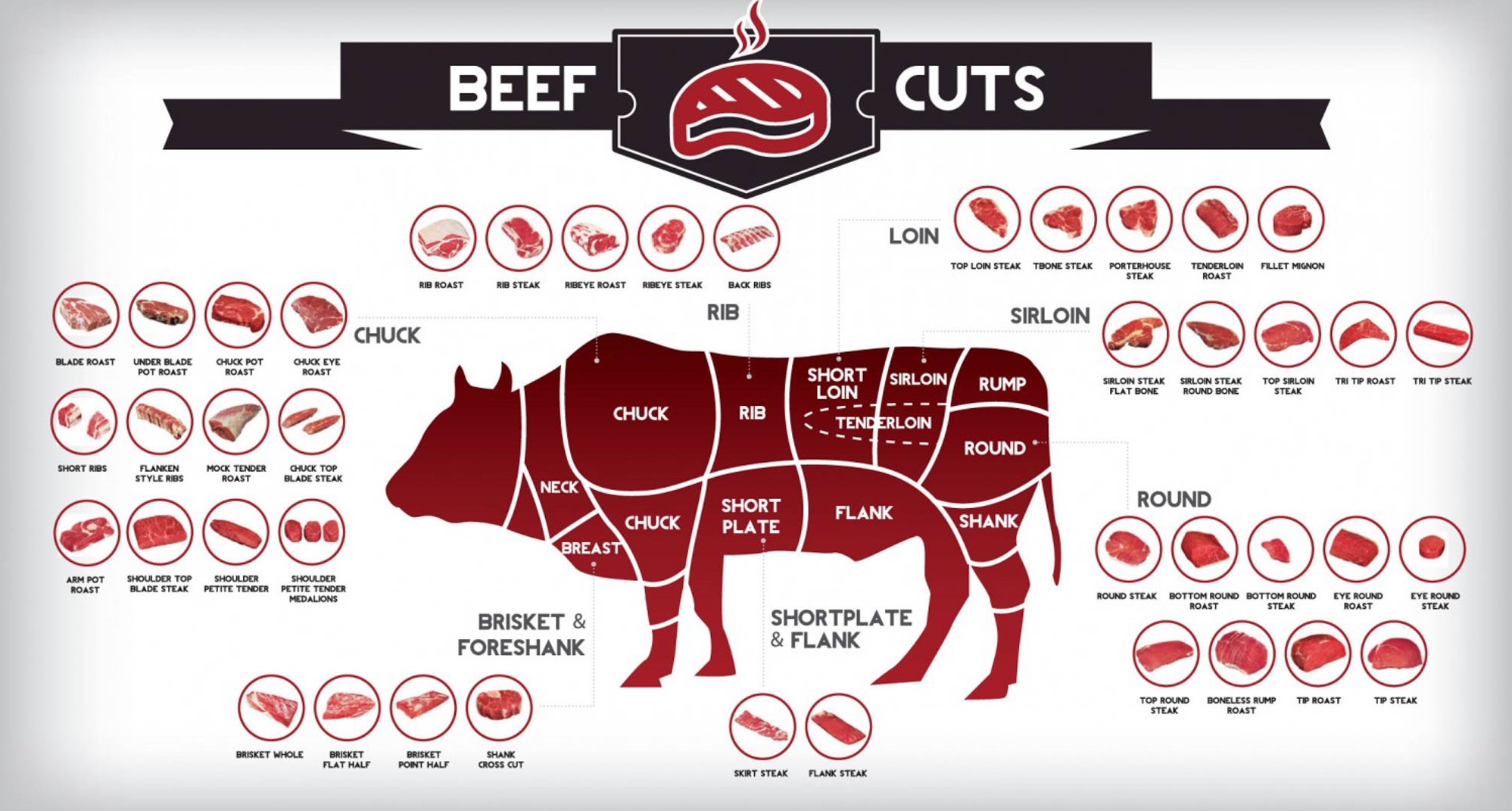 Chuck
Chuck
Chuck comes from the cow’s shoulder. It’s a very flavorful region that can be cut and prepared in many ways, but it’s also typically a firmer cut of beef. Due to its versatility and cheap cost, chuck is probably what you’re most familiar with. It’s great for any type of cooking!
The types of portion cuts you can find for chuck are ground chuck (hamburgers), chuck short ribs, shoulder tender medallions, chuck pot roast, shoulder steak, flat-iron steak and stew meat, amongst others.
Rib
As the name implies, the rib primal cut refers to meat cut from the cow’s ribs and backbone. Of the 13 pairs of ribs on a cow, only the last six are classified in this section – the rest are grouped with chuck and short plate! Rib cuts are notable for their fatty marbling, tenderness, and distinctive flavor. Rib cuts tend to be a little pricier than most and are often better slow-cooked than grilled.
The types of portion cuts you can find for ribs are beef short ribs, ribeye steak, cowboy steak, ribeye roast, ribeye filet and back ribs.
Loin
This is where you’ll find your most expensive cuts of beef. The loin is located directly behind the ribs and, due to its location, is not a heavily used muscle. This makes loin very tender compared to more muscular cuts. The loin primal cut comprises two parts worth mentioning: sirloin and short loin.
Sirloin is the rearmost cut of the loin region and the least tender of the two subregions (though arguably more flavorful). Sirloin is typically best for grilling and almost never used for slow cooking. Common cuts include sirloin steak, top sirloin, bottom sirloin, tri-tip roast and tri-tip steak.
Short loin is similar to sirloin cuts, but is closer to the center of the cow and more tender than sirloin cuts as a result. Like sirloin, it dries out very fast so it’s typically best grilled or fried. Common short loin cuts include NY strip, T-Bone, porterhouse, tenderloin filet, filet mignon and strip loin.
Round
The round primal region is an inexpensive, lean cut. Located near the cow’s hind legs, it’s typically a tough cut of beef. Due to the leanness of this cut, it’s important to thoroughly research how to prepare and cook the individual portion cuts of this primal region; sometimes it calls for high heat cooking (like top, bottom and eye round portion cuts), or slow-cooking (like rump and eye roast).
The common round cuts you can expect to find in stores are round steak, eye of round, tip roast, tip steak, top round and bottom round roasts.
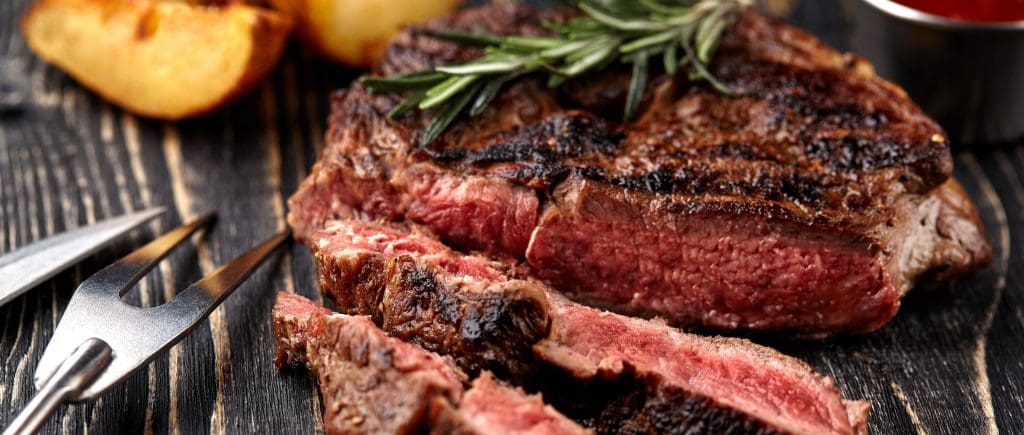
Flank
The flank primal cut is located just below the loin. This region has no bones, but is flavorful despite its toughness. In the past, it was typically the least expensive cut one could find in a store. However, as the recent demand for lean meat increased, so did the demand for flank steak – driving its popularity and price up.
Typically you’ll only find one of two flank cuts: a flank steak or a skirt steak, both of which are best grilled at high heat.
Short Plate
Often grouped with the brisket beef region, short plate cuts are found near the stomach of the cow. Its location in the cow lends to cheap, tough and fatty cuts of beef. This is also where you’ll find your other source of marbled short ribs.
The most common short plate portion cuts you can expect to find in stores are skirt steak, hanger steak, beef bacon, pastrami, short ribs and ground beef from this primal cut.
Brisket
A barbecue favorite, the brisket cut belongs to a cow’s breast. Brisket is known for its fatty, tough texture, but if prepared correctly (low and slow) it can be cooked to melt-in-your-mouth perfection. Just be careful when slow cooking – with brisket, there’s a slim margin between juicy and dry! That’s why you should always tenderize and marinate this cut before slow cooking to soften it up.
There’s typically only two cuts of brisket you’ll find widely available: brisket point and brisket flat. They are both better slow-cooked, but the flat is distinguished by its leaner quality.
Shank
Shank is arguably the toughest, cheapest cut of beef. Located in front of the brisket at the cow’s forearm, this beef cut is notable for its sinewy dryness. Due to its lack of popularity, shank is not typically found in retail stores. However, if you can find it, it’s a great inexpensive option for beef stock or lean ground beef. Because of its dry nature, it’s best cooked for a long time in moist heat.
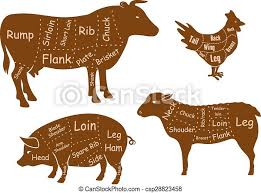
Meat and meat products have significant role in fulfillment and maintenance of human health. Studies indicated that strong nutritional composition (fats, proteins and carbohydrates) with minerals, vitamins and other functional compounds have a preventive role against major and minor nutrients deficiency diseases.
What Butchers Do
Butchers cut, trim, and package meat for retail sale.
Work Environment
Most butchers work in grocery stores and specialty meat shops. The work can be physically demanding and may include exposure to repetitive motions, dangerous equipment, and cold temperatures.
How to Become a Butcher
Butchers typically need no formal educational credential. They learn their skills on the job.
Pay
The median annual wage for butchers was Rs25,000.
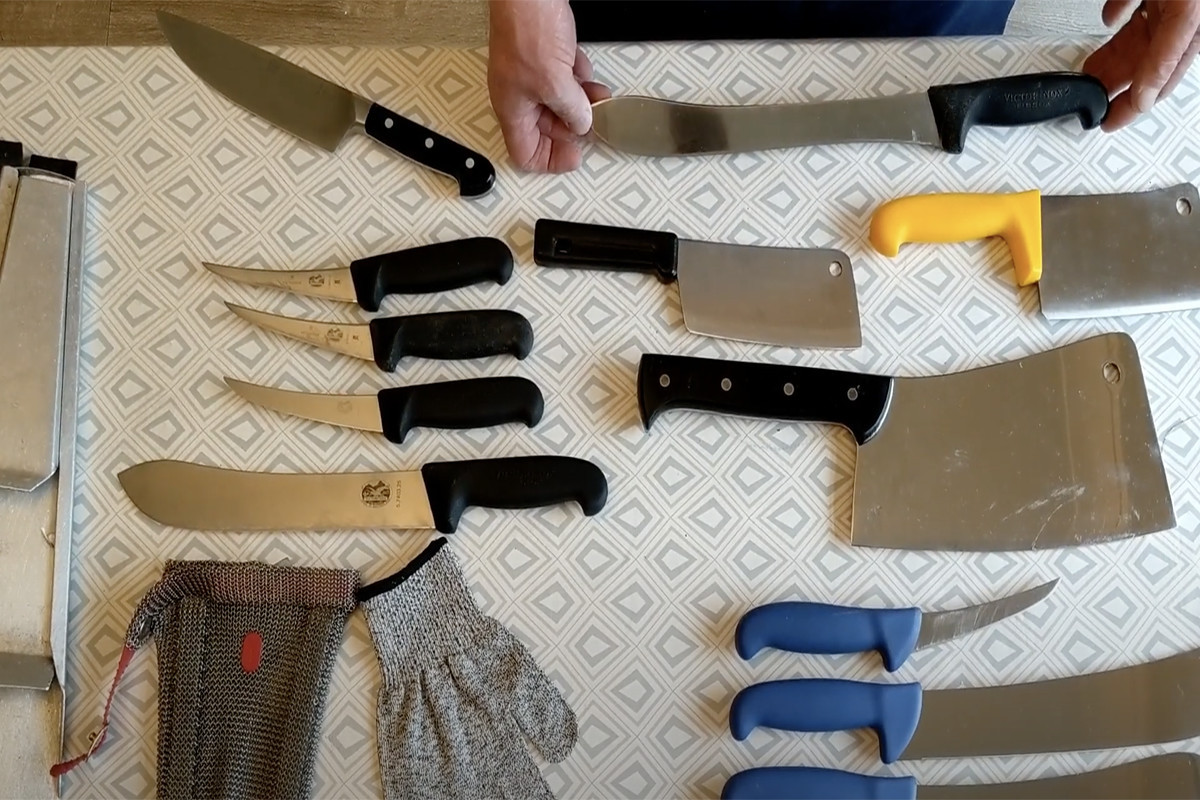
World Wide Festive Trends Decoded What Indian festive consumers seek Generic keywords related to festival shopping such as sale, discount,
How can FMCG Companies improve salesman’s technique in order to sell more? Some FMCG Salesmen, buyers and sellers are more
Why undestand FMCG sales management? Sales management is the process of developing a sales force, coordinating sales operations and implementing






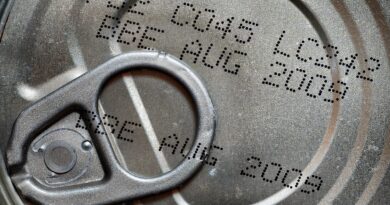

Pingback: local brand influencers+ internet + automate advertising..
Pingback: How are top cooking methods used by all chefs useful to know - DigitalGumma
Hello, I hope you are well. I am reaching out because I think you’d be really interested in a product called Jasper AI. It is a robotic writer powered by AI technology that curates content 5x faster than an average human. With Jasper AI, you receive 100 original content with zero plagiarism flags which are accurately written. You also get pre-written templates on particular categories. Jasper AI writes SEO-friendly content material, which means all of the content that you get by utilizing Jasper AI is optimized and prepared to attract sales.You can try it out for free right here: JasperAI. I’d really love to hear your thoughts once you have tried it out.
Thank You! for your Kind words.